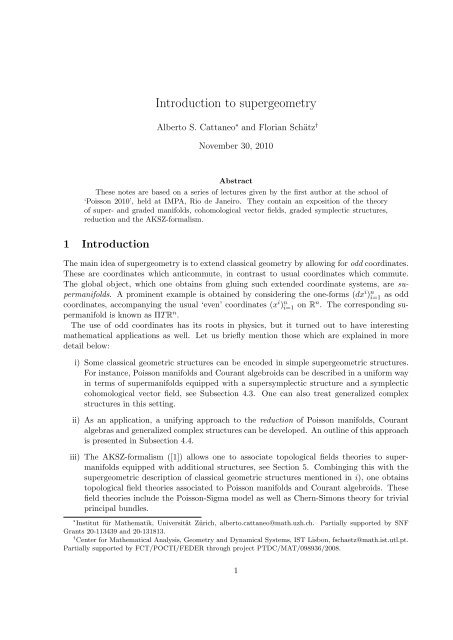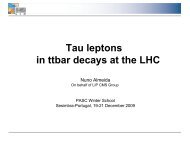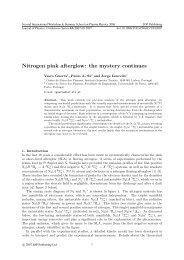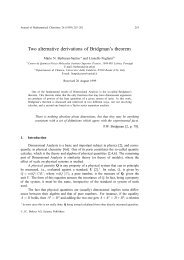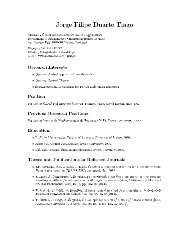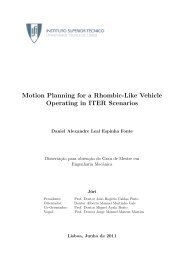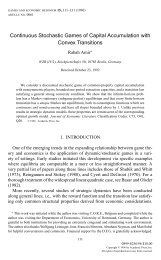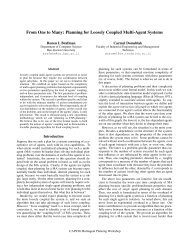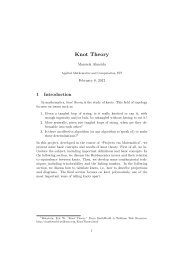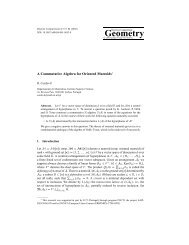Introduction to supergeometry
Introduction to supergeometry
Introduction to supergeometry
Create successful ePaper yourself
Turn your PDF publications into a flip-book with our unique Google optimized e-Paper software.
<strong>Introduction</strong> <strong>to</strong> <strong>supergeometry</strong><br />
Alber<strong>to</strong> S. Cattaneo ∗ and Florian Schätz †<br />
November 30, 2010<br />
Abstract<br />
These notes are based on a series of lectures given by the first author at the school of<br />
‘Poisson 2010’, held at IMPA, Rio de Janeiro. They contain an exposition of the theory<br />
of super- and graded manifolds, cohomological vec<strong>to</strong>r fields, graded symplectic structures,<br />
reduction and the AKSZ-formalism.<br />
1 <strong>Introduction</strong><br />
The main idea of <strong>supergeometry</strong> is <strong>to</strong> extend classical geometry by allowing for odd coordinates.<br />
These are coordinates which anticommute, in contrast <strong>to</strong> usual coordinates which commute.<br />
The global object, which one obtains from gluing such extended coordinate systems, are supermanifolds.<br />
A prominent example is obtained by considering the one-forms (dx i ) n i=1 as odd<br />
coordinates, accompanying the usual ‘even’ coordinates (x i ) n i=1 on Rn . The corresponding supermanifold<br />
is known as ΠT R n .<br />
The use of odd coordinates has its roots in physics, but it turned out <strong>to</strong> have interesting<br />
mathematical applications as well. Let us briefly mention those which are explained in more<br />
detail below:<br />
i) Some classical geometric structures can be encoded in simple supergeometric structures.<br />
For instance, Poisson manifolds and Courant algebroids can be described in a uniform way<br />
in terms of supermanifolds equipped with a supersymplectic structure and a symplectic<br />
cohomological vec<strong>to</strong>r field, see Subsection 4.3. One can also treat generalized complex<br />
structures in this setting.<br />
ii) As an application, a unifying approach <strong>to</strong> the reduction of Poisson manifolds, Courant<br />
algebras and generalized complex structures can be developed. An outline of this approach<br />
is presented in Subsection 4.4.<br />
iii) The AKSZ-formalism ([1]) allows one <strong>to</strong> associate <strong>to</strong>pological fields theories <strong>to</strong> supermanifolds<br />
equipped with additional structures, see Section 5. Combinging this with the<br />
supergeometric description of classical geometric structures mentioned in i), one obtains<br />
<strong>to</strong>pological field theories associated <strong>to</strong> Poisson manifolds and Courant algebroids. These<br />
field theories include the Poisson-Sigma model as well as Chern-Simons theory for trivial<br />
principal bundles.<br />
∗ Institut für Mathematik, Universität Zürich, alber<strong>to</strong>.cattaneo@math.uzh.ch. Partially supported by SNF<br />
Grants 20-113439 and 20-131813.<br />
† Center for Mathematical Analysis, Geometry and Dynamical Systems, IST Lisbon, fschaetz@math.ist.utl.pt.<br />
Partially supported by FCT/POCTI/FEDER through project PTDC/MAT/098936/2008.<br />
1
Plan of the notes<br />
Section 2 is a short review of the basics of <strong>supergeometry</strong>.<br />
In Section 3, graded manifolds, as well as graded and cohomological vec<strong>to</strong>r fields, are introduced.<br />
The concept of cohomological vec<strong>to</strong>r fields allows one <strong>to</strong> think of ‘symmetries’, which<br />
appear in a wide variety of examples, in a unified and geometric way. For instance, L ∞ -algebras<br />
and Lie algebroid structures can be seen as special instances of cohomological vec<strong>to</strong>r fields.<br />
In Section 4, graded symplectic manifolds are explained. Due <strong>to</strong> the additional grading, graded<br />
symplectic geometry often behaves much more rigidly than its ungraded counterpart. A dg symplectic<br />
manifold is a graded symplectic manifold with a compatible cohomological vec<strong>to</strong>r field.<br />
Poisson manifolds, Courant algebroids and generalized complex structures fit naturally in<strong>to</strong> the<br />
framework of dg symplectic manifolds. This is explained in Subsection 4.3, while Subsection 4.4<br />
outlines a unified approach <strong>to</strong> the reduction of these structures via graded symplectic geometry.<br />
Finally, Section 5 provides an introduction <strong>to</strong> the AKSZ-formalism ([1]). This is a procedure<br />
which allows one <strong>to</strong> associate <strong>to</strong>pological field theories <strong>to</strong> dg symplectic manifolds. As particular<br />
examples, one recovers the Poisson Sigma model and Chern-Simons theory (for trivial principal<br />
bundles). In this Section, we basically follow the expositions of the AKSZ-formalism from [17]<br />
and [8], respectively.<br />
Acknowledgements. We thank Dmitry Royenberg, Pavol Ševera and Marco Zambon for helpful<br />
comments. Moreover, we thank the school of ‘Poisson 2010’ for partial financial support.<br />
2 Supermanifolds<br />
2.1 Definition<br />
A supermanifold M is a locally ringed space (M, O M ) which is locally isomorphic <strong>to</strong><br />
(U, C ∞ (U) ⊗ ∧W ∗ ),<br />
where U is an open subset of R n and W is some finite-dimensional real vec<strong>to</strong>r space.<br />
isomorphism mentioned above is in the category of Z 2 -graded algebras, i.e. the parity<br />
⊕<br />
C ∞ (U) ⊗ ∧ k W ∗ → Z 2 , f ⊗ x ↦→ |f ⊗ x| := |x| = k mod 2<br />
k≥0<br />
has <strong>to</strong> be preserved.<br />
Loosly speaking, every supermanifold is glued from pieces that look like open subsets of R n ,<br />
<strong>to</strong>gether with some odd coordinates, which correspond <strong>to</strong> a basis of W ∗ . The supermanifold<br />
corresponding <strong>to</strong> such a local piece is denoted by U × ΠW , and we write<br />
C ∞ (U × ΠW ) := C ∞ (U) ⊗ ∧W ∗ .<br />
Similarly, the algebra of polynomial functions on V × ΠW , for V and W real, finite dimensional<br />
vec<strong>to</strong>r spaces, is S(V ∗ ) ⊗ ∧W ∗ . Here S(V ∗ ) denotes the symmetric algebra of the vec<strong>to</strong>r space<br />
V ∗ .<br />
In the global situation, the algebra of smooth function C ∞ (M) on a supermanifold M is<br />
defined <strong>to</strong> be the algebra of global sections of the sheaf associated <strong>to</strong> M. The parity extends <strong>to</strong><br />
C ∞ (M) and C ∞ (M) is a graded commutative algebra with respect <strong>to</strong> this parity, i.e. for f and<br />
g homogeneous elements of degree |f| and |g| respectively, one has<br />
f · g = (−1) |f||g| g · f.<br />
The<br />
2
Examples 2.1.<br />
1. The algebra of differential forms Ω(M) on a manifold M is locally isomorphic <strong>to</strong><br />
C ∞ (U) ⊗ ∧T ∗ x M<br />
where x is some point on U. Hence the sheaf of differential forms on a manifold corresponds<br />
<strong>to</strong> a supermanifold.<br />
2. Let g be a real, finite dimensional Lie algebra. The cochains of the Chevalley-Eilenberg<br />
complex of g are the elements of ∧g ∗ , which is the same as the algebra of smooth functions<br />
on the supermanifold Πg.<br />
2.2 Morphisms of supermanifolds<br />
Since supermanifolds are defined as certain locally ringed spaces, it is natural <strong>to</strong> define morphisms<br />
of supermanifolds as morphims of these locally ringed spaces. In the smooth setting,<br />
one can equivalently define morphisms from M <strong>to</strong> N <strong>to</strong> be morphisms of superalgebras from<br />
C ∞ (N ) <strong>to</strong> C ∞ (M), see [24] or [7].<br />
Let us spell this out in more detail for the local case, i.e. consider a patch of N isomorphic<br />
<strong>to</strong> Ṽ × Π ˜W . In this situation one has<br />
Mor(M, N ) ∼ = Mor alg (C ∞ (N ), C ∞ (M)) ∼ =<br />
(<br />
(Ṽ ⊕ Π ˜W<br />
)<br />
) ⊗ C ∞ (M) .<br />
even<br />
Here, the last object is a super vec<strong>to</strong>r space, i.e. a vec<strong>to</strong>r space with a decomposition in<strong>to</strong> an<br />
even and an odd part. C ∞ (M) is graded by the parity, Ṽ ⊕ Π ˜W is considered with its obvious<br />
decomposition and the parity of a tensor product a ⊗ b is the product of the parities of a and b,<br />
respectively.<br />
The last isomorphism uses the fact that it suffices <strong>to</strong> know the restriction of a morphism<br />
C ∞ (Ṽ × Π ˜W ) → C ∞ (M)<br />
<strong>to</strong> the subspace of linear functions, in order <strong>to</strong> be able <strong>to</strong> recover the morphism itself.<br />
3 Graded manifolds<br />
3.1 Definition<br />
Let us first introduce the relevant linear theory: A graded vec<strong>to</strong>r space V is a collection of vec<strong>to</strong>r<br />
spaces (V i ) i∈Z . The algebra of polynomial functions on V is the graded symmetric algebra S(V ∗ )<br />
over V ∗ . In more detail:<br />
• The dual V ∗ of a graded vec<strong>to</strong>r space V is the graded vec<strong>to</strong>r space (V ∗ −i ) i∈Z.<br />
• The graded symmetric algebra S(W ) over a graded vec<strong>to</strong>r space W is the quotient of the<br />
tensor algebra of W by the ideal generated by the elements of the form<br />
v ⊗ w − (−1) |v||w| w ⊗ v<br />
for any homoegenous elements v and w of W .<br />
3
A morphism f : V → W of graded vec<strong>to</strong>r spaces is a collection of linear maps<br />
(f i : V i → W i ) i∈Z .<br />
The morphisms between graded vec<strong>to</strong>r spaces are also referred <strong>to</strong> as graded linear maps.<br />
Moreover, V shifted by k is the graded vec<strong>to</strong>r space V [k] given by (V i+k ) i∈Z . By definition, a<br />
graded linear map of degree k between V and W is a graded linear map between V and W [k].<br />
The definition of a graded manifold is analogous <strong>to</strong> that of supermanifold, but now in the<br />
graded setting:<br />
• The local model is<br />
(U, C ∞ (U) ⊗ S(W ∗ )),<br />
where U is an open subset of R n and W is a graded vec<strong>to</strong>r space.<br />
• The isomorphism between the structure sheaf and the local model is in the category of<br />
Z-graded algebras.<br />
The algebra of smooth functions of a graded manifold (M, O M ) (i.e. algebra of global sections)<br />
au<strong>to</strong>matically inherits a Z-grading. Morphisms between graded manifolds are morphisms of<br />
locally ringed spaces. In the smooth setting, one can equivalently consider morphisms of the<br />
Z-graded algebra of smooth functions.<br />
Essentially all examples of graded manifolds come from graded vec<strong>to</strong>r bundles, which are<br />
generalizations of graded vec<strong>to</strong>r spaces. A graded vec<strong>to</strong>r bundle E over a manifold M is a<br />
collection of ordinary vec<strong>to</strong>r bundles (E i ) i∈Z over M. The sheaf<br />
U ↦→ Γ(U, S(E| ∗ U))<br />
corresponds <strong>to</strong> a graded manifold which we will also denote by E from now on. It can be shown<br />
that any graded manifold is isomorphic <strong>to</strong> a graded manifold associated <strong>to</strong> a graded vec<strong>to</strong>r<br />
bundle.<br />
Examples 3.1.<br />
1. For V an ordinary vec<strong>to</strong>r space, one has C ∞ (V [1]) = ∧V ∗ . In particular, the space of<br />
cochains of the Chevalley-Eilenberg complex of a Lie algebra g is equal <strong>to</strong> C ∞ (g[1]).<br />
2. The algebra of differential forms Ω(M) is the algebra of smooth functions on T [1]M.<br />
3.2 Graded vec<strong>to</strong>r fields<br />
Let V be a graded vec<strong>to</strong>r space with homogeneous coordinates (x i ) n i=1<br />
of V ∗ . A vec<strong>to</strong>r field on V is a linear combination of the form<br />
corresponding <strong>to</strong> a basis<br />
X =<br />
n∑<br />
i=1<br />
X i<br />
∂<br />
∂x i<br />
where (X i ) n i=1 is a tuple of functions on V , i.e. of elements of S(V ∗ ), and ( ∂ ) n ∂x i i=1 is the basis of<br />
V dual <strong>to</strong> (x i ) n i=1 . The vec<strong>to</strong>r field X acts on the algebra of functions according <strong>to</strong> the following<br />
rules:<br />
4
• ∂<br />
∂x i (x j ) = δ j i and<br />
• ∂<br />
∂x i (fg) = ( ∂<br />
∂x i (f) ) g + (−1) |xi ||f| f ( ∂<br />
∂x i (g) ) .<br />
A vec<strong>to</strong>r field is graded if it maps functions of degree m <strong>to</strong> functions of degree m + k for some<br />
fixed k. In this case, the integer k is called the degree of X.<br />
Globally, graded vec<strong>to</strong>r fields on a graded manifold can be identified with graded derivations<br />
of the algebra of smooth functions. Accordingly, a graded vec<strong>to</strong>r field on M is a graded linear<br />
map<br />
which satisfies the graded Leibniz rule, i.e.<br />
X : C ∞ (M) → C ∞ (M)[k]<br />
X(fg) = X(f)g + (−1) k|f| fX(g)<br />
holds for all homogenoeus smooth functions f and g. The integer k is called the degree of X.<br />
Example 3.2. Every graded manifold comes equipped with the graded Euler vec<strong>to</strong>r field which<br />
can be defined in two ways:<br />
• In local coordinates (x i ) n i=1 , it is given by<br />
E =<br />
n∑<br />
i=1<br />
|x i |x i ∂<br />
∂x i .<br />
• Equivalently, it is the derivation which acts on homogeneous smooth functions via<br />
3.3 Cohomological vec<strong>to</strong>r fields<br />
E(f) = |f|f.<br />
Definition 3.3. A cohomological vec<strong>to</strong>r field is a graded vec<strong>to</strong>r field of degree +1 which commutes<br />
with itself.<br />
Remark 3.4. Observe that the graded commuta<strong>to</strong>r equips the graded vec<strong>to</strong>r space of graded<br />
vec<strong>to</strong>r fields with the structure of a graded Lie algebra: if X and Y are graded derivations of<br />
degree k and l respectively, then<br />
[X, Y ] := X ◦ Y − (−1) kl Y ◦ X<br />
is a graded derivation of degree k + l.<br />
It is left as an exercise <strong>to</strong> the reader <strong>to</strong> verify that in local coordinates (x i ) n i=1 , the graded<br />
commuta<strong>to</strong>r [X, Y ] of<br />
is equal <strong>to</strong><br />
X =<br />
n∑<br />
i,j=1<br />
n∑<br />
i=1<br />
X i<br />
X i ∂Y j<br />
∂x i<br />
∂<br />
∂x i and Y =<br />
∂<br />
∂x j − (−1)♯<br />
n∑<br />
i,j=1<br />
n∑<br />
j=1<br />
Y j<br />
Y j ∂Xi<br />
∂x j<br />
∂<br />
∂x j<br />
∂<br />
∂x i ,<br />
5
for some appropriate sign ♯.<br />
Futhermore, one can check that the degree of a graded vec<strong>to</strong>r field X is its eigenvalue with<br />
respect <strong>to</strong> the Lie derivative along E, i.e.<br />
[E, X] = deg(X)X.<br />
Let Q be a graded vec<strong>to</strong>r field of degree +1, i.e. Q is a linear map<br />
Q : C ∞ (M) → C ∞ (M)[1]<br />
which satisfies the graded Leibniz rule. Because of<br />
[Q, Q] = 2 (Q ◦ Q) ,<br />
every cohomological vec<strong>to</strong>r field on M corresponds <strong>to</strong> a differential on the graded algebra of<br />
smooth functions C ∞ (M).<br />
Examples 3.5.<br />
1. Consider the shifted tangent bundle T [1]M, whose algebra of smooth functions is equal <strong>to</strong><br />
the algebra of differential forms Ω(M). The de Rham differential on Ω(M) corresponds <strong>to</strong><br />
a cohomological vec<strong>to</strong>r field Q on T [1]M.<br />
We fix local coordinates (x i ) n i=1 on M and denote the induced fiber coordinates on T [1]M<br />
by (dx i ) n i=1 . In the coordinate system (xi , dx i ) n i=1 , the cohomological vec<strong>to</strong>r field Q is given<br />
by<br />
Q =<br />
n∑<br />
dx i ∂<br />
∂x i .<br />
i=1<br />
2. Let g be a real, finite dimensional Lie algebra. The graded manifold g[1] carries a cohomological<br />
vec<strong>to</strong>r field Q which corresponds <strong>to</strong> the Chevalley-Eilenberg differential on<br />
∧g ∗ = C ∞ (g[1]).<br />
In more detail, let (e i ) n i=1 be a basis of g, and (f ij k ) be the corresponding structure constants<br />
given by<br />
[e i , e j ] =<br />
Then, the cohomological vec<strong>to</strong>r field Q reads<br />
1<br />
2<br />
n∑<br />
i,j,k=1<br />
n∑<br />
fije k k . (1)<br />
k=1<br />
x i x j fij<br />
k ∂<br />
∂x k ,<br />
where (x i ) n i=1 are the coordinates on g[1] which correspond <strong>to</strong> the basis dual <strong>to</strong> (e i) n i=1 .<br />
Actually, one can check that [Q, Q] = 0 is equivalent <strong>to</strong> the statement that the bracket<br />
[−, −] : g ⊗ g → g defined via formula (1) satisfies the Jacobi-identity.<br />
3. One can generalize the last example in two directions:<br />
6
• allowing for higher degrees: let V be a graded vec<strong>to</strong>r space with only finitely many<br />
non-zero homogeneous components, all of which are finite dimensional. Formal 1 cohomological<br />
vec<strong>to</strong>r fields on V are in one-<strong>to</strong>-one correspondence with L ∞ -algebra<br />
structures on V .<br />
• allowing for a non-trivial base: let A be a vec<strong>to</strong>r bundle over a manifold M. Cohomological<br />
vec<strong>to</strong>r fields on A[1] are in one-<strong>to</strong>-one correspondence with Lie algebroids<br />
structures on A. This observation is due <strong>to</strong> Vaintrob [23].<br />
Definition 3.6. A graded manifold endowed with a cohomological vec<strong>to</strong>r field is called a differential<br />
graded manifold, or dg manifold for short.<br />
A morphism of dg manifolds is a morphism of graded manifolds, with respect <strong>to</strong> which the<br />
cohomological vec<strong>to</strong>r field are related.<br />
Remark 3.7. Morphisms of dg manifolds can be defined equivalently by requiring that the<br />
corresponding morphisms between the algebra of smooth functions is a chain map with respect<br />
<strong>to</strong> the differentials given by the cohomological vec<strong>to</strong>r fields.<br />
Remark 3.8. So far we elaborated on the condition [Q, Q] = 0 mostly from an algebraic<br />
perspective. However, it has also geometric significance, as we will see now. Assume X is a<br />
graded vec<strong>to</strong>r field of degree k on a graded manifold M. We want <strong>to</strong> construct the flow of X,<br />
i.e. solve the ordinary differential equation<br />
dx i (t)<br />
dt<br />
in a coordinate chart of M, where X is given by<br />
n∑<br />
i=1<br />
= X i (x(t)) (2)<br />
X i<br />
∂<br />
∂x i .<br />
Observe that the degree of the components X i is |x i |+k. Consequently we have <strong>to</strong> assign degree<br />
−k <strong>to</strong> the time parameter t in order for the two sides of the flow equation <strong>to</strong> have the same<br />
degree. Although we will not introduce the concept of maps between graded manifolds until<br />
Section 5, let us mention that one can think of the solution of equation (2) as a map<br />
R[k] → M.<br />
Now, assume that X is of degree +1. This implies that t is of degree −1 and hence squares <strong>to</strong><br />
zero. The expansion of the flow with respect <strong>to</strong> t looks like<br />
x i (t) = x i + tv i<br />
where v i is of degree |x i | + 1. On the one hand, this implies<br />
dx i (t)<br />
dt<br />
= v i<br />
1 Formal cohomological vec<strong>to</strong>r fields are elements of the completion of the space of vec<strong>to</strong>r fields with respect<br />
<strong>to</strong> the degree, i.e. one considers Ŝ(V ∗ ) ⊗ V instead of S(V ∗ ) ⊗ V . The subset of (ordinary) cohomological vec<strong>to</strong>r<br />
fields corresponds <strong>to</strong> L ∞-algebra structures on V whose structure maps V ⊗n → V [1] vanish for all but finitely<br />
many n.<br />
7
while on the other hand,<br />
holds. Using the flow equation, we obtain<br />
X i (x(t)) = X i (x) + t<br />
n∑<br />
j=1<br />
∂X i<br />
∂x j vj<br />
v i = X i (x)<br />
and<br />
n∑<br />
j=1<br />
∂X i<br />
∂x j vj = 0,<br />
which combines in<strong>to</strong><br />
n∑<br />
j=1<br />
∂X i<br />
∂x j Xj = 0 ⇔ [X, X] = 0.<br />
So [X, X] = 0 turns out <strong>to</strong> be a necessary and sufficient condition for the integrability of X. This<br />
conclusion can be seen as a special instance of Frobenius Theorem for smooth graded manifolds,<br />
see [6].<br />
4 Graded symplectic geometry<br />
4.1 Differential forms<br />
Locally, the algebra of differential forms on a graded manifold M is constructed by adding new<br />
coordinates (dx i ) n i=1 <strong>to</strong> a system of homogeneous local coordinates (xi ) n i=1 of M. Moreover, one<br />
assigns the degree |x i | + 1 <strong>to</strong> dx i .<br />
Remark 4.1.<br />
1. If x i is a coordinate of odd degree, dx i is of even degree and consequently<br />
(dx i ) 2 ≠ 0.<br />
2. On an ordinary smooth manifold, differential forms have two important properties: they<br />
can be differentiated – hence the name differential forms – and they also provide the right<br />
objects for an integration theory on submanifolds. It turns out that on graded manifolds,<br />
this is no longer true, since the differential forms we introduced do not come along with<br />
a nice integration theory. To solve this problem, one has <strong>to</strong> introduce new objects, called<br />
‘integral forms’. The interested reader is referred <strong>to</strong> [14].<br />
A global description of differential forms on M is as follows: the shifted tangent bundle T [1]M<br />
carries a natural structures of a dg manifold with a cohomological vec<strong>to</strong>r field Q that reads<br />
n∑<br />
dx i ∂<br />
∂x i<br />
i=1<br />
in local coordinates. The de Rham complex (Ω(M), d) of M is C ∞ (T [1]M), equipped with the<br />
differential corresponding <strong>to</strong> the cohomological vec<strong>to</strong>r field Q.<br />
Remark 4.2. The classical Cartan calculus extens <strong>to</strong> the graded setting:<br />
8
1. Let X be a graded vec<strong>to</strong>r field on M and ω a differential form. Assume their local<br />
expressions in a coordinate system (x i ) n i=1 are<br />
X =<br />
n∑<br />
i=1<br />
X i<br />
∂<br />
∂x i and ω =<br />
n∑<br />
ω i1···i k<br />
dx i1 · · · dx i k<br />
,<br />
i 1 ,··· ,i k =1<br />
respectively.<br />
The contraction ι X ω of X and ω is given locally by<br />
n∑<br />
i 1 ,··· ,i k =1 l=1<br />
k∑<br />
±ω i1···i k<br />
X i l<br />
dx i1 · · · ̂dx i l · · · dx<br />
i k<br />
.<br />
Alternatively – and <strong>to</strong> get the signs right – one uses the following rules:<br />
• ι ∂<br />
∂x i dx j = δ j i ,<br />
• ι ∂<br />
∂x i is a graded derivation of the algebra of differential forms of degree |x i | − 1.<br />
2. The Lie derivative is defined via Cartan’s magic formula<br />
L X ω := ι X dω + (−1) |X| dι X ω.<br />
If one considers both ι X and d as graded derivations, L X is their graded commuta<strong>to</strong>r<br />
[d, ι X ]. It follows immediately that<br />
holds.<br />
[L X , d] = 0<br />
Let us compute the Lie derivative with respect <strong>to</strong> the graded Euler vec<strong>to</strong>r field E in local<br />
coordinates (x i ). By definition<br />
and consequently<br />
L E x i = |x i |x i<br />
L E dx i = dL E x i = |x i |dx i .<br />
This implies that L E acts on homogenous differential forms on M by multiplication by the<br />
difference between the <strong>to</strong>tal degree – i.e. the degree in C ∞ (T [1]M) – and the form degree –<br />
which is given by counting the ‘d’s, loosly speaking. We call this difference the degree of a<br />
differential form ω and denote it by deg ω.<br />
4.2 Basic graded symplectic geometry<br />
Definition 4.3. A graded symplectic form of degree k on a graded manifold M is a two-form<br />
ω which has the following properties:<br />
• ω is homogeneous of degree k,<br />
• ω is closed with respect <strong>to</strong> the de Rham differential,<br />
9
• ω is non-degenerate, i.e. the induced morphism of graded vec<strong>to</strong>r bundles<br />
is an isomorphism.<br />
ω : T M → T ∗ [k]M<br />
A graded symplectic manifold of degree k is a pair (M, ω) of a graded manifold M and a<br />
graded symplectic form ω of degree k on M.<br />
Examples 4.4.<br />
1. Ordinary symplectic structures on smooth manifolds can be seen as graded symplectic<br />
structures.<br />
2. Let V be a real vec<strong>to</strong>r space. The contraction between V and V ∗ defines a symmetric<br />
non-degenerate pairing on V ⊕ V ∗ . This pairing is equivalent <strong>to</strong> a symplectic form of<br />
degree k + l on V [k] ⊕ V ∗ [l].<br />
3. Consider R[1] with the two-form ω = dxdx. This is a symplectic form of degree 2.<br />
Lemma 4.5. Let ω be a graded symplectic form of degree k ≠ 0. Then ω is exact.<br />
Proof. One computes<br />
kω = L E ω = dι E ω.<br />
This implies ω = dι Eω<br />
k . □<br />
Definition 4.6. Let ω be a graded symplectic form on a graded manifold M.<br />
A vec<strong>to</strong>r field X is called ...<br />
• symplectic if the Lie derivative of ω with respect <strong>to</strong> X vanishes, i.e. L X ω = 0,<br />
• Hamil<strong>to</strong>nian if the contraction of X and ω is an exact one-form, i.e. there is a smooth<br />
function H such that ι X ω = dH.<br />
Lemma 4.7. Suppose ω is a graded symplectic form of degree k and X is a symplectic vec<strong>to</strong>r<br />
field of degree l. If k + l ≠ 0, then X is Hamil<strong>to</strong>nian.<br />
Proof. By definition, we have<br />
Set H := ι E ι X ω and compute<br />
[E, X] = lX and L X ω = dι X ω = 0.<br />
dH = dι E ι X ω = L E ι X ω − ι E dι X ω = ι [E,X] ω = (k + l)ι X ω.<br />
Hence ι X ω = dH<br />
k+l .<br />
□<br />
Remark 4.8. Lemma 4.5 and Lemma 4.7 can be found in [16].<br />
10
Example 4.9. Let (M, ω) be a graded symplectic manifold and Q a symplectic cohomological<br />
vec<strong>to</strong>r field. By definition, the degree of Q is 1. Lemma 4.7 implies that Q is Hamil<strong>to</strong>nian if<br />
k = deg ω ≠ −1. We remark that the exceptional case k = −1 is also relevant since it appears<br />
in the BV-formalism ([4, 19, 22]).<br />
Assume that Q is Hamil<strong>to</strong>nian. Similar <strong>to</strong> the ungraded case, the graded symplectic form<br />
induces a bracket {−, −} via<br />
{f, g} := (−1) |f|+1 X f (g)<br />
where X f is the unique graded vec<strong>to</strong>r field that satisfies ι Xf ω = df. It can be checked that<br />
{−, −} satisfies relations similar <strong>to</strong> the ordinary Poisson bracket. Using the bracket, one can<br />
express Q with the help of a Hamil<strong>to</strong>nian function S by<br />
Since<br />
Q = {S, −}.<br />
[Q, Q](f) = {{S, S}, f}<br />
The relation [Q, Q] = 0 is equivalent <strong>to</strong> {S, S} being a constant.<br />
Observe that S can be chosen of degree k + 1, while the bracket {−, −} decreases the degree<br />
by k. Consequently, the degree of {S, S} is k +2. Since constants are of degree 0, k ≠ −2 implies<br />
{S, S} = 0.<br />
This last equation is known as the classical master equation.<br />
Definition 4.10. A graded manifold endowed with a graded symplectic form and a symplectic<br />
cohomological vec<strong>to</strong>r field is called a differential graded symplectic manifold, or dg symplectic<br />
manifold for short.<br />
4.3 Examples of dg symplectic manifolds<br />
Next, we study some special cases of dg symplectic manifolds (M, ω, Q), where we assume the<br />
cohomological vec<strong>to</strong>r field Q <strong>to</strong> be Hamil<strong>to</strong>nian with Hamil<strong>to</strong>nian function S. As before, k<br />
denotes the degree of the graded symplectic form ω. As mentioned before, the case k = −1<br />
occures in the BV-formalism ([4] and [19, 22]).<br />
1. Consider the case k = 0. This implies that S is of degree 1. Since the degree of the graded<br />
symplectic form is zero, it induces an isomorphism between the coordinates of positive<br />
and negative degree. Assuming that S is non-trivial, there must be coordinates of positive<br />
degree – and hence of negative degree as well. We remark that the situation just described<br />
appears in the BFV-formalism ([2, 3]).<br />
2. Suppose k > 0 and that all the coordinates are of non-negative degree. Dg symplectic<br />
manifolds with that property were called dg symplectic N-manifolds by P. Ševera, (letter<br />
nr. 8 of [20] and [21]). Let us look at the case k = 1 and k = 2 in more detail:<br />
(a) k = 1. The graded symplectic structure induces an isomorphism between the coordinates<br />
of degree 0, which we denote by (x i ) n i=1 , and the coordinates in degree 1,<br />
11
which we denote by (p i ) n i=1 . All other degrees are excluded, since the would imply<br />
that coordinates of negative degree are around.<br />
The Hamil<strong>to</strong>nian S has degree 2, so locally it must be of the form<br />
S = 1 2<br />
n∑<br />
π ij (x)p i p j .<br />
i,j=1<br />
Hence, locally S corresponds <strong>to</strong> a bivec<strong>to</strong>r field and the classical master equation<br />
{S, S} = 0 implies that S actually corresponds <strong>to</strong> a Poisson bivec<strong>to</strong>r field. This also<br />
holds globally, as the following Theorem due <strong>to</strong> A. Schwarz ([19]) asserts:<br />
Theorem 4.11. Let (M, ω) be a graded symplectic structure of degree 1. Then<br />
(M, ω) is symplec<strong>to</strong>morphic <strong>to</strong> T ∗ [1]M, equipped with the standard symplectic form.<br />
Moreover, one can choose M <strong>to</strong> be an ordinary manifold.<br />
The Theorem provides us with an isomorphism<br />
C ∞ (M) ∼ = C ∞ (T ∗ [1]M) = Γ(∧T M),<br />
which maps the bracket {−, −} induced by ω <strong>to</strong> the Schouten-Nijenhuis bracket on<br />
Γ(∧T M). A smooth function S of degree 2 is mapped <strong>to</strong> a bivec<strong>to</strong>r field π and if S<br />
satisfies the classical master equation, π will be Poisson.<br />
Hence, there is a one-<strong>to</strong>-one correspondence<br />
isomorphism classes of dg symplectic N-manifolds of degree 1<br />
<br />
1 1<br />
<br />
isomorphism classes of Poisson manifolds.<br />
(b) k = 2. It was noticed by P. Ševera (see letter nr. 7 of [20]) that there is a one-<strong>to</strong>-one<br />
correspondence<br />
isomorphism classes of dg symplectic N-manifolds of degree 2<br />
<br />
1 1<br />
<br />
isomorphism classes of Courant algebroids.<br />
We will not spell out the details of this correspondence – the interested reader can<br />
find them in [20] or [16].<br />
Observe that the degree of the graded symplectic form ω allows for coordinates in<br />
degree 0, 1 and 2. We denote them by (x i ) n i=1 , (ξα ) A α=1 and (p i) n i=1 , respectively. The<br />
graded symplectic form can be written as<br />
ω =<br />
n∑<br />
dp i dx i + 1 2<br />
i=1<br />
n∑<br />
d (g αβ (x)ξ α ) dξ β ,<br />
α,β=1<br />
where (g αβ ) is a symmetric non-degenerate form.<br />
Globally, the graded symplectic form ω corresponds <strong>to</strong> T ∗ [2]M and an additional<br />
vec<strong>to</strong>r bundle E over M, equipped with a non-degenerate fibre pairing g.<br />
12
A Hamil<strong>to</strong>nian function S for a cohomological vec<strong>to</strong>r field on such a graded manifold<br />
is locally of the form<br />
S = ∑ i,α<br />
ρ i α(x)p i ξ α + 1 6<br />
∑<br />
f αβγ (x)ξ α ξ β ξ γ .<br />
The first term corresponds <strong>to</strong> a bundle map ρ : E → T M, while the second one gives<br />
a bracket [−, −] on Γ(E).<br />
The classical master equation {S, S} = 0 is equivalent <strong>to</strong> the statement that (ρ, [−, −])<br />
equips (E, g) with the structure of a Courant algebroid.<br />
(c) Following J. Grabowski ([11]), it is possible <strong>to</strong> include generalized complex structures<br />
on Courant algebroids in the graded picture as follows: Assume that S is a Hamil<strong>to</strong>nian<br />
function for a symplectic cohomological vec<strong>to</strong>r field on a graded symplectic<br />
manifold of degree 2. We want <strong>to</strong> construct a two-parameter family of solutions of<br />
the classical master equation, i.e. we look for a smooth function T of degree 3 such<br />
that<br />
α,β,γ<br />
{αS + βT, αS + βT } = 0<br />
is satisfied for all constants α and β.<br />
An important class of solutions arises when one finds a smooth function J of degree<br />
2 such that T = {S, J} satisfies {T, T } = 0. Under these circumstances, T will solve<br />
the above two-parameter version of the classical master equation. One way <strong>to</strong> assure<br />
{T, T } = 0 is <strong>to</strong> require<br />
{{S, J}, J} = λS<br />
<strong>to</strong> hold for some constant λ. Up <strong>to</strong> rescaling, λ is −1, 0 or 1. For λ = −1, such a<br />
smooth function J yields a generalized complex structure on the Courant algebroid<br />
corresponding <strong>to</strong> S, if J does not depend on the dual coordinates (p i ) n i=1 .<br />
4.4 Graded symplectic reduction<br />
We recall some facts about reduction of presymplectic submanifolds. This can be extended<br />
<strong>to</strong> graded symplectic manifolds and provides a unified approach <strong>to</strong> the reduction of Poisson<br />
structures, Courant algebroids and generalized complex structures. This Subsection relies on<br />
[5], [6], [9] and [10], respectively.<br />
Definition 4.12. Let (M, ω) be a symplectic manifold. A submanifold i : S ↩→ M is presymplectic<br />
if the two-form i ∗ ω has constant rank.<br />
In this case the kernel of i ∗ ω forms an integrable distribution D of S, called the characterisitic<br />
distribution, and we denote its space of leaves by S.<br />
Example 4.13. A special class of presymplectic manifolds are coisotropic submanifolds. A<br />
submanifold S is coisotropic if for every point x ∈ S, the symplectic orthogonal of T x S is<br />
contained in T x S. Equivalently, one can require that S is given locally by the zero-set of<br />
constraints in involution, i.e. there is a submanifold chart of S with coordinates (x i , y a ) such<br />
that<br />
• S is given locally by {y a ≡ 0} and<br />
13
• the Poisson bracket {y a , y b } of any two constraints lies in the ideal of the algebra of smooth<br />
functions generated by the transverse coordinates (y a ).<br />
Lemma 4.14. Let i : S ↩→ M be a presymplectic submanifold of (M, ω). If S carries a smooth<br />
structure such that the canonical projection<br />
π : S → S<br />
is a submersion, there is a unique symplectic structure ω on S which statisfies<br />
π ∗ ω = i ∗ ω.<br />
Remark 4.15. From now on, we will always assume that S can be equipped with a smooth<br />
structure such that the natural projection from S is a submersion. Assuming this, the symplectic<br />
manifold (S, ω) is called the reduction of S.<br />
Definition 4.16. Let i : S ↩→ M be a presymplectic submanifold of (M, ω).<br />
A function f ∈ C ∞ (M) is called<br />
• S-reducible, if i ∗ f is invariant under the characteristic distribution D.<br />
• strongly S-reducible, if the Hamil<strong>to</strong>nian vec<strong>to</strong>r field of f is tangent <strong>to</strong> S.<br />
Lemma 4.17.<br />
• Let f be an S-reducible function. There is a unique smooth function f on S satisfying<br />
π ∗ f = i ∗ f.<br />
• Let f be strongly S-reducible. Then the following assertions hold:<br />
1. f is S-reducible.<br />
2. The restriction X f | S of the Hamil<strong>to</strong>nian vec<strong>to</strong>r field of f <strong>to</strong> S is projectable, i.e.<br />
[X f | S , D] ⊂ D.<br />
This implies that there is a unique vec<strong>to</strong>r field X f on S which is π-related <strong>to</strong> X f | S ,<br />
i.e. T x π(X f ) x = (X f ) π(x) holds for all x ∈ S.<br />
3. The vec<strong>to</strong>r field X f is the Hamil<strong>to</strong>nian vec<strong>to</strong>r field of f.<br />
Proof. Let f be an S-reducible function. To establish the existence and uniqueness of f, one<br />
observes that i ∗ f is constant along the fibres of<br />
π : S → S<br />
and hence descends <strong>to</strong> a function f on S. Smoothness of f follows from the assumption that π<br />
is a surjective submersion, which implies that a function on S is smooth if and only if its pull<br />
back by π is.<br />
From now on, let f be a strongly S-reducible function. We first show that f is also S-reducible,<br />
i.e. that it is invariant under the characteristic distribution D of S. The identities<br />
L X i ∗ f = ι X (di ∗ f) and (i ∗ df)(X) = i ∗ ω(X f | S , X),<br />
14
where X f is the Hamil<strong>to</strong>nian vec<strong>to</strong>r field of f, imply<br />
L X i ∗ f = 0<br />
for all X ∈ Γ(D), since D is the kernel of i ∗ ω.<br />
Next, we claim that the commuta<strong>to</strong>r of X f | S and an arbitrary vec<strong>to</strong>r field X on S, with values<br />
in D, is a vec<strong>to</strong>r field with values in D <strong>to</strong>o. To this end, we compute<br />
This guarantees that<br />
ι [X,Xf | S ]i ∗ ω = ([L X , ι Xf | S<br />
])i ∗ ω = L X (ι Xf | S<br />
i ∗ ω) = L X i ∗ df = 0.<br />
X f | S (π ∗ g)<br />
is S-reducible and one can define a linear endomorphism of C ∞ (S) by<br />
g ↦→ X f | S (π ∗ g).<br />
It is easy <strong>to</strong> check that this is a derivation of C ∞ (S) and hence corresponds <strong>to</strong> a vec<strong>to</strong>r field X f<br />
on S. By construction, X f | S and X f are π-related; uniqueness of X f follows from π being a<br />
surjective submersion.<br />
The final claim follows from<br />
π ∗ (df) = i ∗ df = ι Xf | S<br />
i ∗ ω = π ∗ (ι Xf ω).<br />
Lemma 4.18. Let S be a coisotropic submanifold. Then the notion of S-reducibility is equivalent<br />
<strong>to</strong> the notion of strong S-reducibility.<br />
Remark 4.19.<br />
• The above definitions and statements can be extended <strong>to</strong> graded symplectic manifolds.<br />
• In the last Subsection, we saw that any Poisson manifold gives rise <strong>to</strong> a dg symplectic<br />
manifold (M, ω) of degree 1 with Hamil<strong>to</strong>nian function Θ of degree 2.<br />
Let S be a graded presymplectic submanifold of M and suppose that Θ is strongly reducible.<br />
Graded reduction yields a new graded symplectic manifold (S, ω) of degree 1.<br />
Moreover, Θ induces a smooth function Θ on S which satisfies<br />
{Θ, Θ} = X Θ (Θ) = X Θ (Θ) = X Θ (Θ) = 0.<br />
Hence, one obtains a new dg symplectic manifold of degree 1, which corresponds <strong>to</strong> a new<br />
Poisson manifold.<br />
• Similarly, one can reduce dg manifolds of degree 2, which correspond <strong>to</strong> Courant algebroids.<br />
Furthermore, it is possible <strong>to</strong> include generalized complex structures if one assumes that<br />
the corresponding function J of degree 2 is strongly reducible as well.<br />
Remark 4.20. It is also possible <strong>to</strong> extend Marsden-Weinstein reduction <strong>to</strong> graded symplectic<br />
manifolds by allowing Hamil<strong>to</strong>nian graded group actions, see [9].<br />
□<br />
15
Example 4.21. Let us consider the case of the dg symplectic manifolds arising from a Poisson<br />
manifold (M, π) in more detail. Recall that the corresponding graded symplectic manifold is<br />
M := (T ∗ [1]M), equipped with the standard symplectic form.<br />
Every coisotropic submanifold S corresponds <strong>to</strong> a submanifold C of M and an integrable<br />
distrubtion B on C. Reducibility of the Hamil<strong>to</strong>nian function Θ, which corresponds <strong>to</strong> the<br />
Poisson bivec<strong>to</strong>r field π, is equivalent <strong>to</strong>:<br />
1. The image of the restriction of the bundle map π ♯ : T ∗ M → T M <strong>to</strong> the conormal bundle<br />
N ∗ C of C is contained in B.<br />
2. For any two function f and g on M whose restriction <strong>to</strong> C is invariant with respect <strong>to</strong> the<br />
distribution B, the restriction of the Poisson bracket of f and g <strong>to</strong> C is invariant <strong>to</strong>o.<br />
Suppose that these conditions hold and that the leaf space M of B admits a smooth structure<br />
such that the natural projection p : C → M is a surjective submersion. Setting<br />
{f, g} := {˜p ∗ f, ˜p ∗ g},<br />
defines a Poisson structure on M. Here, ˜p ∗ f denotes a smooth extension of p ∗ f <strong>to</strong> M,<br />
What one recovers here is a particular case of Marsden-Ratiu reduction, see [15]. More interesting<br />
examples can be obtained by considering presymplectic submanifolds, see [9, 10].<br />
5 An introduction <strong>to</strong> the AKSZ-formalism<br />
The AKSZ-formalism goes back <strong>to</strong> the article [1] of M. Alexandrov, M. Kontsevich, A. Schwarz<br />
and O. Zaboronsky. It is a procedure that allows one <strong>to</strong> construct solutions <strong>to</strong> the classical<br />
master equation on mapping spaces between graded manifolds that are equipped with additional<br />
structures. Particularly interesting examples arise from mapping spaces between shifted tangent<br />
bundles and dg symplectic manifolds. This allows one <strong>to</strong> associate <strong>to</strong>pological field theories <strong>to</strong> dg<br />
symplectic manifolds, encompassing examples such as Chern-Simons theory (on trivial principal<br />
bundles) and the Poisson-sigma model.<br />
Let us describe the AKSZ-formalism in a nutshell. The ‘input data’ are:<br />
• The source N : a dg manifold, equipped with a measure which is invariant under the<br />
cohomological vec<strong>to</strong>r field.<br />
• The target M: a dg symplectic manifold, whose cohomological vec<strong>to</strong>r field is Hamil<strong>to</strong>nian.<br />
Out of this, the AKSZ-formalism tailors:<br />
• a graded symplectic structure on the space of maps C ∞ (N , M) and<br />
• a symplectic cohomological vec<strong>to</strong>r field on C ∞ (N , M).<br />
Under mild conditions, symplectic cohomological vec<strong>to</strong>r fields are Hamil<strong>to</strong>nian and one might<br />
find a Hamil<strong>to</strong>nian function which commutes with itself under the Poisson bracket. Hence,<br />
in many cases the AKSZ-formalism produces a solution of the classical master equation on<br />
C ∞ (N , M).<br />
In the following, we 1) describe the relevant mapping spaces between graded manifolds and<br />
2) give an outline of the AKSZ-formalism.<br />
16
5.1 Maps of graded manifolds<br />
Given two graded manifold X and Y , the set of morphisms Mor(X, Y ) was defined <strong>to</strong> be the set<br />
of morphisms of Z-graded algebras from C ∞ (Y ) <strong>to</strong> C ∞ (X).<br />
The category of graded manifolds admits a monoidal structure ×, which is the coproduct<br />
of locally ringed spaces. From a categorical perspective, one might wonder whether the set<br />
Mor(X, Y ) can be equipped with the structure of a graded manifold in a natural way, such that<br />
it is the adjoint <strong>to</strong> the monoidal structure, i.e. such that there is a natural isomorphism<br />
Mor(Z × X, Y ) ∼ = Mor(Z, Mor(X, Y ))<br />
for arbitrary graded manifolds X, Y and Z.<br />
This turns out not <strong>to</strong> be possible. However, there actually is a (usually infinite dimensional)<br />
graded manifold Map(X, Y ) canonically associated <strong>to</strong> a pair (X, Y ), which satisfies<br />
Mor(Z × X, Y ) ∼ = Mor(Z, Map(X, Y )).<br />
Moreover, there is a natural inclusion of Mor(X, Y ) in<strong>to</strong> Map(X, Y ) as the submanifold of degree<br />
0.<br />
Remark 5.1.<br />
1. Usually, Map(X, Y ) is an infinite-dimensional object. However, there are noteworthy finite<br />
dimensional examples such as Map(R[1], X) = T [1]X.<br />
2. The difference between Mor and Map can be illustrated in the following example: While<br />
Mor(X, R) is equal <strong>to</strong> the elements of C ∞ (X) in degree 0, the mapping space Map(X, R)<br />
is equal <strong>to</strong> the whole of C ∞ (X).<br />
3. Similarly, the infinitesimal object associated <strong>to</strong> the group of invertible morphisms from<br />
X <strong>to</strong> X is the Lie algebra of vec<strong>to</strong>r fields of degree 0, whereas considering the group of<br />
invertible elements of the mapping space Map(X, X) yields the graded Lie algebra of all<br />
vec<strong>to</strong>r fields on X<br />
Remark 5.2. Let us spell out Mor and Map in the local picture, i.e. for two graded vec<strong>to</strong>r<br />
spaces V and W . One has<br />
Mor(V, W ) = Mor(C ∞ (W ), C ∞ (V )) = (W ⊗ C ∞ (V )) 0<br />
where (W ⊗ C ∞ (V )) is considered as a graded vec<strong>to</strong>r space and the superscript 0 refers <strong>to</strong> the<br />
elements in degree 0. In contrast <strong>to</strong> this,<br />
holds<br />
5.2 Lifting geometric structures<br />
Map(V, W ) = W ⊗ C ∞ (V )<br />
Geometric structures on the graded manifolds X and Y induce interesting structures on the<br />
mapping space Map(X, Y ). For instance, cohomogical vec<strong>to</strong>r fields on X and Y can be lifted <strong>to</strong><br />
commuting cohomological vec<strong>to</strong>r fields on Map(X, Y ). Another example is a graded symplectic<br />
structure on Y and an invariant measure on X, which allow one <strong>to</strong> construct a graded symplectic<br />
structure on Map(X, Y ). Let us elaborate on this in more detail:<br />
17
1. The groups of invertible maps Diff(X) and Diff(Y ) act on Map(X, Y ) by composition and<br />
these two actions commute. Differentiation yields commuting infinitesimal actions<br />
X (X)<br />
L X (Map(X, Y )) R<br />
X (Y ).<br />
Now, suppose Q X and Q Y are cohomological vec<strong>to</strong>r fields on X and Y . We denote their<br />
images under L – respectively R – by Q L X and QR Y<br />
. Their sum<br />
Q := Q L X + Q R Y<br />
is then a cohomological vec<strong>to</strong>r field on Map(X, Y ).<br />
2. Suppose Y carries a graded symplectic form ω. Any form α ∈ Ω(Y ) can be pulled back <strong>to</strong><br />
a form on Map(X, Y ) × Y via the evaluation map<br />
ev : Map(X, Y ) × X → Y.<br />
To produce a differential form on the mapping space Map(X, Y ), some notion of push<br />
forward along X is required. To this end, the theory of Berezinian measures and Berezinian<br />
integration is needed – the interested reader might consult [14]. Basically, this is an<br />
extension of the usual (Lebesgue-) integration theory by adding the rule<br />
∫<br />
ξdξ = 1<br />
for each odd coordinate ξ. For instance, if one considers integration on a graded vec<strong>to</strong>r<br />
space V concentrated in odd degrees, the integration map<br />
C ∞ (V ) = ∧V ∗ → R<br />
is just the projection <strong>to</strong> the <strong>to</strong>p exterior product (which we identify with R). Another special<br />
case is provided by X = T [1]Σ, where Σ is some compact, smooth, oriented manifold.<br />
The graded manifold X carries a canonical measure which maps a function f on X <strong>to</strong><br />
∫ ∫<br />
f := j(f),<br />
where j denotes the isomorphism between C ∞ (X) and Ω(Σ).<br />
X<br />
Assuming that X = T [1]Σ is equipped with its canonical measure, we obtain a map<br />
which is of degree − dim(Σ).<br />
Ω(Y ) → Ω(Map(X, Y ))<br />
∫<br />
α ↦→ ˆα := ev ∗ α<br />
Furthermore, one can check that if ω is a graded symplectic form of degree k on Y , ˆω is a<br />
graded symplectic form of degree k − dim(Y ) on Map(X, Y ).<br />
Σ<br />
X<br />
18
3. We want <strong>to</strong> combine the structures obtained in 1.) and 2.). First, we assume that the<br />
cohomological vec<strong>to</strong>r field Q Y is Hamil<strong>to</strong>nian with Hamil<strong>to</strong>nian function Θ. This implies<br />
that Q R Y<br />
is also Hamil<strong>to</strong>nian with respect <strong>to</strong> the graded symplectic structure ˆω – in fact,<br />
ˆΘ is a Hamil<strong>to</strong>nian function.<br />
Concerning the source X, we concentrate on the case X = T [1]Σ, equipped with the cohomological<br />
vec<strong>to</strong>r field Q X which corresponds <strong>to</strong> the de Rham differential. The canonical<br />
measure on X is invariant with respect <strong>to</strong> the cohomological vec<strong>to</strong>r field in the sense that<br />
∫<br />
Q X (f) = 0<br />
X<br />
holds for every smooth function f. It follows from invariance that Q L X<br />
with respect <strong>to</strong> ˆω. We denote the Hamil<strong>to</strong>nian function by S 0 .<br />
is also Hamil<strong>to</strong>nian<br />
Example 5.3. Let Y be a graded symplectic vec<strong>to</strong>r space of degree 1, equipped with the<br />
standard exact symplectic form dα. By Theorem 4.11, Y is symplec<strong>to</strong>morphic <strong>to</strong> T ∗ [1]V , for<br />
some vec<strong>to</strong>r space V . Moreover, a symplectic cohomological vec<strong>to</strong>r field on Y corresponds <strong>to</strong><br />
a Poisson bivec<strong>to</strong>r field π on V . Suppose (q i ) are local coordinates on V and denote the dual<br />
fibre coordinates on T ∗ [1]V by (p i ). The set of coordinates (q i , p i ) of Y , <strong>to</strong>gether with a set of<br />
coordinates (x i , dx i ) of X = T [1]Σ, induces a set of coordinates (X i , η i ) on Map(X, Y ). In these<br />
coordinates, the Hamil<strong>to</strong>nian S 0 for the lift of the de Rham differential on X <strong>to</strong> the mapping<br />
space reads<br />
∫<br />
S 0 = ± η i dX i ,<br />
Σ<br />
while the Hamil<strong>to</strong>nian function for the lift of the cohomological vec<strong>to</strong>r field on Y is given by<br />
ˆΘ = 1 ∫<br />
π ij (X)η i η j .<br />
2<br />
Σ<br />
The sum of S 0 and ˆΘ is the BV action functional of the Poisson sigma model on Σ. This is a<br />
<strong>to</strong>pological field theory associated <strong>to</strong> Poisson structures, which was discovered by N. Ikeda ([12])<br />
and P. Schaller and T. Strobl ([18]).<br />
Remark 5.4. Assuming that the graded symplectic form ω on Y is of degree k, the Hamil<strong>to</strong>nian<br />
function Θ has degree k + 1. If one assumes in addition that Σ is of dimension n, the graded<br />
symplectic form ˆω on Map(X, Y ) is of degree k − n and the Hamil<strong>to</strong>nian function ˆΘ is of degree<br />
k + 1 − n.<br />
The case n = k + 1 corresponds <strong>to</strong> the BV-formalism – introduced by Batalin and Vilkovisky<br />
([4]), while n = k corresponds <strong>to</strong> the BFV-formalism – introduced by Batalin, Fradkin and<br />
Vilkovisky ([2, 3]). These <strong>to</strong>gether with the cases k < n should be related <strong>to</strong> extended <strong>to</strong>pological<br />
fields theories in the sense of Lurie ([13]).<br />
References<br />
[1] M. Alexandrov, M. Kontsevich, A. Schwarz, O. Zaboronsky, The geometry of the Master<br />
equation and <strong>to</strong>pological quantum field theory, Int. J. Modern Phys. A, 12(7),1405–1429,<br />
1997<br />
19
[2] I. A. Batalin and E. S. Fradkin, A generalized canonical formalism and quantization of<br />
reducible gauge theories, Phys. Lett. B 122, 157–164 (1983)<br />
[3] I. A. Batalin and G. A. Vilkovisky, Relativistic S-matrix of dynamical systems with boson<br />
and fermion constraints, Phys. Lett. B 69 (1977), 309–312<br />
[4] I. A. Batalin, G. A. Vilkovisky, Gauge algebra and quantization, Phys. Lett., 102B:27, 1981<br />
[5] H. Bursztyn, A. S. Cattaneo, R. Mehta, and M. Zambon, Generalized reduction via graded<br />
geometry, in preparation.<br />
[6] H. Bursztyn, A. S. Cattaneo, R. Metha, and M. Zambon. The Frobenius theorem for graded<br />
manifolds and applications in graded symplectic geometry, in preparation.<br />
[7] C. Carmeli, L. Cas<strong>to</strong>n and R. Fioresi, Mathematical Foundation of Supersymmetry, with<br />
an appendix with I. Dimitrov, EMS Ser. Lect. Math., European Math. Soc., Zurich 2011<br />
[8] A. S. Cattaneo, G. Felder, On the AKSZ formulation of the Poisson sigma model, Lett.<br />
Math. Phys., 56, 163–179, 2001<br />
[9] A. S. Cattaneo and M. Zambon, A supergeometric approach <strong>to</strong> Poisson reduction,<br />
arxiv:1009.0948<br />
[10] A. S. Cattaneo and M. Zambon, Graded geometry and Poisson reduction, American Institute<br />
of Physics Conference Proceedings 1093, 48–56<br />
[11] J. Grabowski, Courant-Nijenhuis tensors and generalized geometries, Monografías de la<br />
Real Academia de Ciencias de Zaragoza 29 (2006), 101–112<br />
[12] N. Ikeda, Two-dimensional gravity and nonlinear gauge theory, Ann. Phys. 235, (1994)<br />
435–464<br />
[13] J. Lurie, On the classification of <strong>to</strong>pological field theories, Current Developments in Mathematics<br />
(2009), 129–280<br />
[14] Yu. Manin, Gauge fields and complex geometry, Springer-Verlag, Berlin, 1997<br />
[15] J. E. Marsden and T. Ratiu, Reduction of Poisson manifolds, Lett. Math. Phys. 11 (1986),<br />
161–169.<br />
[16] D. Roytenberg, On the structure of graded symplectic supermanifolds and Courant algebroids,<br />
in: Quantization, Poisson Brackets and Beyond, Th. Voronov (ed.), Contemp. Math,<br />
Vol. 315, Amer. Math. Soc., Providence, RI, 2002<br />
[17] D. Roytenberg, AKSZ-BV formalism and Courant algebroid-induced <strong>to</strong>pological field theories,<br />
Lett. Math. Phys. 79, 143 (2007)<br />
[18] P. Schaller, T. Strobl, Poisson structure induced (<strong>to</strong>pological) field theories, Modern Phys.<br />
Lett. A 9 (1994), no. 33, 3129–3136<br />
[19] A. Schwarz, Geometry of Batalin-Vilkovisky quantization, Commun. Math. Phys. 155<br />
(1993), 249–260<br />
20
[20] P. Ševera, Some letters <strong>to</strong> Alan Weinstein, available at<br />
http://sophia.dtp.fmph.uniba.sk/~severa/letters/, between 1998 and 2000<br />
[21] P. Ševera, Some title containing the words “homo<strong>to</strong>py” and “symplectic”, e.g. this one,<br />
Travaux mathématiques XVI (2005), 121–137<br />
[22] P. Ševera, On the Origin of the BV Opera<strong>to</strong>r on Odd Symplectic Supermanifolds, Lett.<br />
Math. Phys., vol. 78 (2006), issue 1, 55–59<br />
[23] A. Vaintrob, Lie algebroids and homological vec<strong>to</strong>r fields, Uspekhi Mat. Nauk, 52(2), 428–<br />
429, 1997<br />
[24] V. S. Varadarajan, Supersymmetry for mathematicians: an introduction, Courant Lecture<br />
Notes Series, New York, 2004<br />
21


